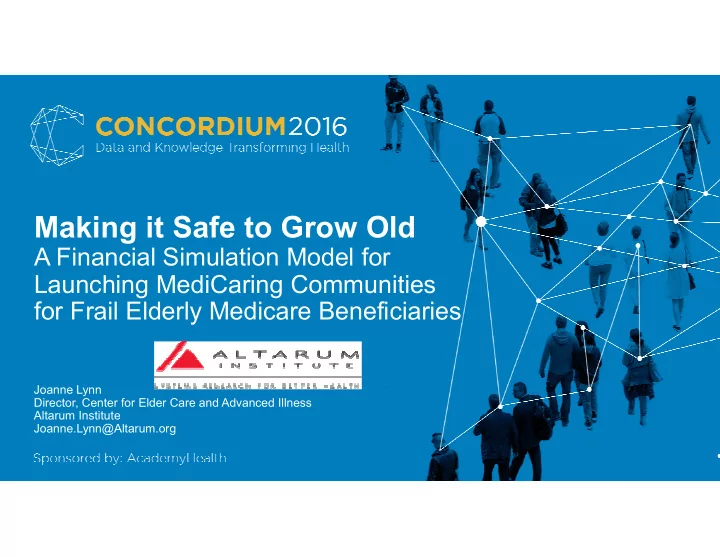

1 Making it Safe to Grow Old A Financial Simulation Model for Launching MediCaring Communities for Frail Elderly Medicare Beneficiaries Joanne Lynn Director, Center for Elder Care and Advanced Illness Altarum Institute Joanne.Lynn@Altarum.org
Single Classic “Terminal” Disease 2 Function ������������� ����� �������������������������������� Time ����������������������� ������������������
Prolonged dwindling 3 ��������������������������� Function ���������� �������������������������! "�������������������#�������$������! ����� �������������������������������� Time ��������������������������� ��������������� ������������������������
Sad Tale #2 – NY Times Sept 28, 2014 4
The MediCaring Community Components 5 J Lynn, MediCaring Communities: Getting what We Want and Need in Frail Old Age at an Affordable Cost. Altarum Institute, 2016. Available on Amazon.com
Frail Elderly People Need Some New 6 Spending… $ Housing $$$ $$$ $ Nutrition $ Personal Care $$$ $ Caregiver training, respite, income $ New drugs and other treatments Where will it come from? $$$ $$$ $$$
My Mother’s Broken Back 7
“The Cost of a Collapsed Vertebra in Medicare” 8
[Better Care & Lower Cost] for Advanced Illness 9 • PACE – 75% lower hospitalizations; 14% lower nursing home • Aetna Compassionate Care – 22% lower net costs • GRACE – net savings 23% • Independence at Home – saving $3070 per person per year • Sutter’s AIM – Medicare saved $760 per person per month • Veteran’s HBPC – VA + Medicare costs reduced 11.7% Summary in J Lynn, MediCaring Communities: Getting What We Want and Need in Frail Old Age at an Affordable Cost. Altarum Institute, 2016, pp 57-66.
Estimating Potential Savings in Medical Care 10 • Working with health care leaders in 4 actual communities • Estimate frail as 10% of >64 population in a geographic area • Estimate PMPM total costs (except for unpaid caregiving) • Use CMS HRR and county data for aggregate costs, population, utilization • Use sources in literature for LTC costs and small ancillary costs • Estimate realistic goals of reducing medical care, delaying Medicaid, reducing use of nursing homes - generally, about half of the maximal effect reported in the literature (e.g., 25% reduction in hospital, 5% in LTC)
Summary Table of Effects 11 MediCaring Literature Estimates Site Estimate Program Effect Service (%) Estimate Notes for Simulation 2009; NY Independence at Home Act 60 29% to -66% -8% to -33% 2012; demonstrations to cut risky hospitalization 61 2006; resource use among elders receiving acute care 62 -10% Inpatient -10% to -25% 2011; hospital admissions/savings with INTERACT II 33 -17% Hospital -20% -18% 2005; two-year GRACE implementation 34 2011; FFS readmits with Care Transitions Intervention 63 -36% -61% 2012; readmissions after psychosocial counseling 64 Outpatient 10% 2005; two-year GRACE implementation 34 Hospital 7% 2005; two-year GRACE implementation 34 Emergency -10% to -10% -25% Services -30% 2009; NY Independence at Home Act 60 -35% to -59% Primary Care 20% 30% 2005; two-year GRACE implementation 34 -1% 2005; two-year GRACE implementation 34 Professional 36% -20% -15% Specialty Care 2005; hospital-at-home model 65 -53% 2012; cost-containing care transition strategies 66 -15% Skilled Nursing -20% to -30% -20% Home Health 5% to 20% 10% 2012; cost-containing care transition strategies 66 20% Hospice 5% to 75% 10% 67% 2013; advance care planning and quality outcomes 67 Ambulance -25% Estimates obtained through local survey Transportation 100% Estimates obtained through local survey 2013; PACE versus Medicare FFS expenditure 68 -28% Medicaid- covered long- -85% 2012; Diversion MCOs as an alternative to HCBS 69 -5% -71% term care 2006; interventions for Alzheimer's patients’ spouses 70 -72%
MediCaring Communities Financial Simulation: Utilization Estimates (Akron, OH) 12 Service Category Without MediCaring With MediCaring Percent Change Absolute Change Inpatient Hospital $966 $725 -25% -$242 Outpatient Hospital $331 $364 10% $33 Professional Primary $270 $351 30% $81 Care Skilled Nursing $315 $252 -20% -$63 Facility Medicaid-covered $2,307 $2,191 -5% -$115 Long-Term Care
MediCaring Communities Financial Simulation 13 Per Beneficiary Per Month Savings ($) by Site, Over Time $600 $537 $500 $467 $400 PBPM Savings ($) $328 $291 $285 $300 $269 $253 $250 $234 Year 1 $200 $153 $136 Year 2 $125 Year 3 $100 $- Akron Milwaukie Queens Williamsburg
MediCaring Communities Financial Simulation 14 Return on Investment, Years 1- 3 350% 300% 289% 279% 250% Return on Investment (%) 200% 150% 148% Akron Milwaukie 100% 97% Queens Williamsburg 50% 0% -50% Year 1 Year 2 Year 3 -100%
A Winning Possibility: MediCaring Communities 15 • Four geographic communities - 15,000 frail elders as steady caseload • Conservative estimates of potential savings from published literature on better care models for frail elders and on implementation Net Savings for CMS • Yields $23 million ROI in first 3 years Beneficiaries Yr 1 Yr 2 Yr 3 3-Yr Before Deducting In-Kind Costs -$2,449,889 $10,245,353 $19,567,328 $27,362,791 After Deducting In-Kind Costs -$3,478,025 $8,463,101 $17,629,209 $22,614,284 For more on financial estimates, see http://www.milbank.org/uploads/documents/Making_It_Safe_to_Grow_Old.pdf and http://medicaring.org/2013/08/20/medicaring4life/
Published online by The Milbank Quarterly, July 2016 16 Original Investigation Making It Safe to Grow Old: A Financial Simulation Model for Launching MediCaring Communities for Frail Elderly Medicare Beneficiaries ANTONIA K. BERNHARDT, JOANNE LYNN, GREGORY BERGER, JAMES A. LEE, KEVIN REUTER, JOAN DAVANZO, ANNE MONTGOMERY, and ALLEN DOBSON http://www.milbank.org/the-milbank-quarterly/early-view-articles
Piloting the MediCaring Community 17 • Use a flexible “Accountable Care Community” • Serve all eligible and willing frail elders • Define geographically • Account for co-existing shared savings models and demos • Many communities with leadership organizations interested • Raising start-up funds appears feasible • Best practices emerge from testing in diverse settings • Can build revenue model from MCO, ACO, SNP, or PACE, with waivers • Successful piloting requires • Rapid cycle improvement with technical assistance • Sustaining the endeavor through shared savings
The MediCaring Community Components 18 J Lynn, MediCaring Communities: Getting what We Want and Need in Frail Old Age at an Affordable Cost. Altarum Institute, 2016. Available on Amazon.com
19 Interested in Research in this Area, Or in Reform in Your Community? Contact us! Joanne.Lynn@Altarum.org
Recommend
More recommend